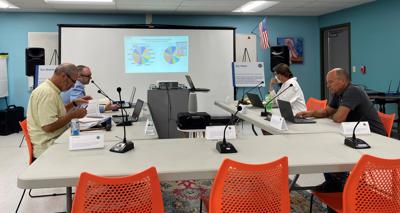The White Salmon Valley School Board is contemplating removing the community service requirement for the graduating class of 2023 and beyond.
Normally, high school seniors would be mandated per district policy to complete 40 hours of community service by the end of the year and a senior project. Should a change in policy occur, which is being recommended by White Salmon Valley Superintendent Sean McGeeney, seniors would be relieved of the responsibility to do community service.
McGeeney said he was able to waive senior projects, with the endorsement of high school principal Craig McKee for graduating seniors. Waiving community service projects, on the other hand, would require concurrence from the board.
The policy proposal parallels state recommendations, McGeeney said, adding that discussions surrounding the idea to change graduation requirements were initiated in the spring by the high school leadership team. With COVID-19 in the foreground, many such requirements were being waived before, he said.
“We’ll be focusing on other areas to get kids ready college and career ready,” McGeeney said.
He said he believes encouraging and promoting community service, rather than mandating it, can do more to instill good character in young people, adding, “I felt it was the right thing to do to honor what kids are going through.”
Board member Laurie Stanton voiced concern that if the district cuts out the requirement, the value of community service could be lost. She said when she attended middle school in White Salmon, the school district allowed students a day off to perform service around the community.
“We’re trying to talk about increasing rigor in the high school … Graduation means something when you graduate from Columbia High,” Stanton said.
Board member Peter Harkema agreed, adding that he didn’t want students to miss out on learning values.
McGeeney said the rigor of the high school’s curriculum comes from the mandatory 24 credits of education needed for graduation.
McGeeney said he plans to bring together a stakeholder group to put together a recommendation to come before the board in a future meeting.
Technology fees
The school board voted Thursday night to adopt a fee schedule for technology used during the 2022-2023 school year. It includes an option to buy into a damage and loss protection coverage plan. If declined, the family assumes full responsibility for any costs due to damage loss or theft.
The plan costs $25 for the first child, $10 per additional child ($50 for the whole family). For families on reduced meals, the plan costs $20, and an additional $8 per child afterwards ($40 for the whole family). If on free meals, the plan costs $10 and an additional $6 per child afterwards ($20 for the whole family).
Through the plan, the first instance of damage is free of cost for repair; second occurrences will cost $35 and a third occurrence will cost $55. If lost or stolen, the flat fee will be $150. If opting out of the plan, the first occurrence of damage will cost $35, to increase to $55 and $75 on the second and third occurrences. If lost or stolen, the cost to replace is $300.
Damage covered includes damage to the screen, keyboard, touchpad, charging port, bezel, or charger.
According to Technology Supervisor Rhonda Hardisty, the fines will cover the costs to replace or repair damaged or broken parts but no more — “It’s just to help pay for parts.”
McGeeney added that fines are at the discretion of the district, meaning anyone demonstrating a hardship can speak with the district about waiving fines. Students will also receive a list of procedures for care for Chromebooks given to students at the beginning of the year. These include rules such as to keep the items free of writing, drawing, or stickers, and to never loan out a Chromebook to others.
Levy set for February
The school board also gave verbal consensus to allow the district to file initial paperwork with the Office of the Superintendent of Public Instruction (OSPI) for putting a levy on the Feb. 23 ballot.
The board concurred with McGeeney to consider two levies on the ballot, including an educational programs and operations levy, and a capital levy. The tax rate in 2021 was $2.58 per $1,000, including $.40 going towards the 2018 bond. This year, taxpayers will pay $2.06 for the levy and $.37 for the levy.
McGeeney said the district’s levy rate to be voted on would be at $1.99 per $1,000 due to a general decline in enrollment, an increase in property values and a cap on levy lid lifts. An addition of 10 cents through voter approval of a capital levy could mean an additional $250,000, and an addition of 20 cents to the levy rate could mean an addition $500,000 for the district’s coffers, negating the $453,622 deficit budgeted this year.
McGeeney said an additional 20 cents to the levy lid would bring the rate back to what taxpayers have normally paid. He added that the district’s consultant recommended the addition of a capital levy to the February ballot that could help fund technology costs to conserve funds in the capital budget.
“It will allow for us to do some capital outlay in terms of things like roofs that need to be replaced, lighting that needs to be replaced,” he said. McGeeney said voters could be asked to approve a capital bond as early as 2024.























Commented